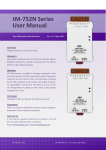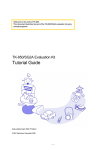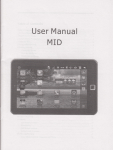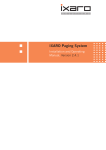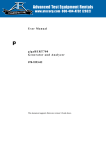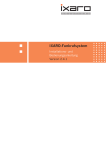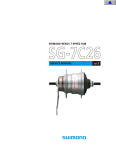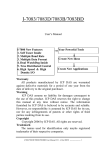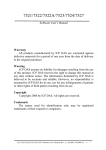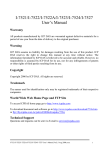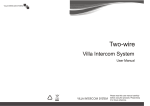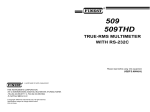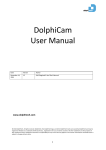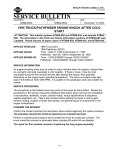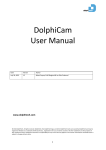Download Manual - TopsCCC
Transcript
EX952N Series (Addressable RS422/485 to RS232 converter) EX952N Quick Manual Introduction EX952N is an Addressable RS422/485 to RS232 converter that it is designed to connect RS422/485 devises to an RS232 network. On most computer systems, industrial device, PLCS, measurement equipment are unbalanced transmission for communication distance, transmission speed, network capability. The EX952N addressable converter solves the problem and let you easily build up an RS485 network with your RS232 devices. Features & Spec. Built in "Addressable RS485 to RS232 Converter" firmware Watchdog timer provides fault tolerance and recovery CPU 80188, 40MHZ o SRAM 256KB o FLASH ROM 512KB o EEPROM 2KB o EMBEDDED OS RomDos(Datalight) o Communication speed: 115.2K bps max o Operating temperature: -25℃ to +75℃ o Storage temperature: -40℃ to +80℃ o Power requirement: Unregulated 10~30 VDC power Series EX9521D, EX9522D, EX9523D, EX9527D Model No. EX9521D EX9522D EX9523D EX9527D COM1 RS232(5wire) RS232(5wire) RS232(5wire) RS232(5wire) COM2 RS485 RS485 RS485 RS485 COM3 x RS232(3wire) RS232(3wire) RS232(3wire) COM4 X X RS232(3wire) RS232(3wire) COM5 X X X RS232(3wire) COM6 X X X RS232(3wire) COM7 X X X RS232(3wire) COM8 X X X RS232(3wire) COM4:Program download RS232 (3wire) EX9521D/22D/23D. COM1:Program download RS232 (5wire) EX9527D. 1 Pin assignment of EX9521/22/23’s COM1 connector (DB-9 Male): Pin 1 2 3 4 5 6 7 8 9 Name DCD RXD TXD DTR GND DSR RTS CTS RI Description Data Carrier Detect Receive Data Transmit Data Data Terminal Ready Signal ground Data Set Ready Request To Send Clear To Send Ring Indicator Use COM4(EX9521/22/23)/COM1(EX9527) for downloading program Power on the system when EX952N module’s INIT* pin is wired to ground and COM4(EX9521/22/23)/COM1(EX9527) is connected to PC. The disk image can be downloaded from PC to flash ROM of 952N module under Hyper-Terminal (Com port setting: baudrate 57600, Databit 8, Parity None, Stopbit1, Flow control None) by clicking “transfer”, “receive file”, then choose Xmodem as the protocol and key in the file name and path. If the update is not successful, then repeat the process. If users want to debug the system from COM4(EX9521/22/23)/COM1(EX9527), just power on the system with INIT* floating. Note: INIT* must be disconnected from ground immediately before the updating disk image completes, otherwise the system will hang. 2 Quick Start Initial pin & GND: Each EX952N module has a build-in EEPROM to store configuration information such as address, type, baudrate and other information. Sometimes, user may forget the configuration. Therefore, the EX952N have a special mode named "INIT mode" , to help user to resolve the problem. The "INIT mode" is setting as Address=00, Baudrate=9600bps, Data bit=8, Parity=none, Stop bit=1, No checksum To enable INIT mode, please following these steps: Step1. Power on the 952N. Step2. Touch the Init* to GND after power on then release the Init* with GND Data format setting (COM port & status): Read/Set the Baud rate: Read /Set the Data-bit: Read /Set the Parity: Read /Set the Stop-bit: $AABN(Baud rate)…..….Page 8 $AADN(Data-bit).………Page 9 $AAPN(Parity-bit).……..Page 10 $AAON(Stop-bit).……….Page 11 Address setting: Use command $AAA(addr)………………………….Page 7 Wire connection: RS-232 R S- 485 Network EX9520 EX9522 R S 232 Device R S 232 Device EX9522 R S 232 Device R S 232 Device 3 Command Sets Command Response Description $AAA(addr) !AA Read/Set the Module Address $AABN(baud rate) !AA(baud rate) Read/Set Baud Rate of COM-1/2/3/4/5/6/7/8 $AADN(data-bit) !AA(data-bit) Read/Set the Data-Bit of COM-1/2/3/4/5/6/7/8 $AAPN(parity-bit) !AA(parity-bit) Read/Set the Parity-Bit of COM-1/2/3/4/5/6/7/8 $AAON(stop-bit) !AA(stop-bit) Read/Set the Stop-Bit of COM-1/2/3/4/5/6/7/8 $AA6(ID) !AA Set the ID-string of COM-1/3/4/5/6/7/8 $AA7 !AA(ID) Read the ID-string of COM-1/3/4/5/6/7/8 $AAC(delimiter) !AA(delimiter) Read/Set the delimiter of COM-1/3/4/5/6/7/8 $AAD !AA(delimiter) Read the delimiter of COM-1/3/4/5/6/7/8 (delimiter) AA (bypass) !AA Bypass data-string to COM-1/3/4/5/6/7/8 $AAKN(CrLfMode) !AA(CrLfMode) Read/Set the checksum-status of COM2(RS485) $AATN(CrLfMode) !AA(CrLfMode) Read/set the end-char of COM-1/2/3/4 $AAXV !AA Set the RTS state of COM1 $AA5 !AAS Read the resent status $AAF !AA(number) Read the firmware version number $AAM !AA(name) Read the module name $AA2 !AABDPK Read the configuration of COM2(RS485) $AAW !AAS Read the CTS status of COM1 $AAU (data) Read data from RS232 COM port buffer 4 Address mapping 9521 9522 9523 9527 COM1(RS232) AA AA AA AA COM2(RS485) AA AA AA AA COM3(RS232) X AA+1 AA+1 AA+1 COM4(RS232) X X AA+2 AA+2 COM5(RS232) X X X AA+3 COM6(RS232) X X X AA+4 COM7(RS232) X X X AA+5 COM8(RS232) X X X AA+6 1. User must send command to COM2(RS-485), if the command is used to set configuration of 952N, the 952N will directly echo message to COM2. If the command is used to bypass data to RS-232 device, the data will be sent to COM1/3/4/5/6/7/8(RS-232). Any message come from COM1/3/4/5/6/7/8(RS-232) will be echo to COM2(RS-485) at any time. 2. The COM port address of 9521 is given as following: COM1=RS-232 --> RS-232 Address=AA COM2=RS-485 3. The COM port address of 9522 is given as following: COM1=RS-232 --> RS-232 Address=AA COM2=RS-485 COM3=RS-232 --> RS-232 Address=AA+1 9522 is used as two 9521 with address AA, AA+1. The COM port must use the same ModeCrLf485 and the ModeCrLf232 can be different. The delimiters for two COM port can be different. 4. The COM port address of 9523 is given as following: COM1=RS-232 --> RS-232 Address=AA COM2=RS-485 COM3=RS-232 --> RS-232 Address=AA+1 COM4=RS-232 --> RS-232 Address=AA+2 9523 is used as three 9521 with address AA, AA+1,AA+2. The three COM port must use the same ModeCrLf485 and the ModeCrLf232 can be different. The delimiters for these three COM port can be different. 5 5. The COM port address of 9527 is given as following: COM1=RS-232 --> RS-232 Address=AA COM2=RS-485 COM3=RS-232 --> RS-232 Address=AA+1 COM4=RS-232 --> RS-232 Address=AA+2 COM5=RS-232 --> RS-232 Address=AA+3 COM6=RS-232 --> RS-232 Address=AA+4 COM7=RS-232 --> RS-232 Address=AA+5 COM8=RS-232 --> RS-232 Address=AA+6 9527 is used as seven 9521 with address AA,AA+1,AA+2,AA+3,AA+4,AA+5,AA+6. The three COM port must use the same ModeCrLf485 and the ModeCrLf232 can be different. The delimiters for these three COM port can be different. 6 1. $AAA(addr) Description: Read/Set the module address Syntax: $AAA(addr)[chk](Cr) $ is a delimiter character AA module address 00 to FF Response: valid command Invalid command !AA ?AA Example: command: $01A02 address 01 is changed to 02 command: $02AA0 receive: !02 receive: !A0 address 02 is changed to 0xA0 command: $00A address stored in EEPROM=02 receive: !02 7 2. $AABN(baud rate) Description: Read/Set the baud rate of COM-1/2/3/4/5/6/7/8 Syntax: $AABN(baud rate)[chk](Cr) $ is a delimiter character AA module address 00 to FF N 0=Read/Set baud rate of RS485, 1=Read/Set baud rate of RS232 (baud rate) 300/600/1200/2400/4800/9600/19200/38400/57600/115200 Response: valid command Invalid command !AA(baud rate) ?AA Example: (Assume the AA of EX9523 is 01) command: $01B0115200 Changes RS485(COM2) to 15200 BPS command: $01B19600 Changes RS232(COM1) to 9600 BPS command: $02B138400 Changes RS232(COM3) to 38400 BPS command: $03B157600 Changes RS232(COM4) to 57600 BPS receive: !01 receive: !01 receive: !02 receive: !03 SHORT-CODE FOR BAUD RATE: 300=1, 600=2, 1200=3, 2400=4, 4800=5, 9600=6, 19200=7, 38400=8, 57600=9,115200=A. The short-code of baud rate will be shown in the 7-SEGMENT LED3. 8 3. $AADN(data-bit) Description: Read /Set the Data-Bit of COM-1/2/3/4/5/6/7/8 Syntax: $AADN(data-bit)[chk](Cr) $ is a delimiter character AA module address 00 to FF N 0=Read/Set the data-bit of RS485, 1=Read/Set the data-bit of RS232 (data-bit): 7 or 8 Response: valid command Invalid command !AA(data-bit) ?AA Example: (Assume the AA of EX9523 is 01) command: $01D08 Changes data-bit of RS485(COM2) to 8 command: $01D17 Changes data-bit of RS232(COM1) to 7 command: $02D17 Changes data-bit of RS232(COM3) to 7 command: $03D17 Changes data-bit of RS232(COM4) to 7 receive: !01 receive: !01 receive: !02 receive: !03 VALID DATA-BIT: COM1 COM2 COM3 COM4 COM5 COM6 COM7 COM8 9521 7/8 7/8 X X X X X X 9522 7/8 7/8 7/8 X X X X X 9523 7/8 7/8 7/8 7/8 X X X X 9524 7/8 7/8 7/8 7/8 X X X X 9527 8 8 7/8 7/8 7/8 7/8 7/8 7/8 9 4. $AAPN(data-bit) Description: Read/Set the parity-bit of COM-1/2/3/4/5/6/7/8 Syntax: $AAPN(parity-bit)[chk](Cr) $ is a delimiter character AA module address 00 to FF N 0=Read/Set the parity-bit of RS485, 1=Read/Set the parity-bit of RS232 (parity-bit): 0=NONE, 1=EVEN, 2=ODD Response: valid command Invalid command !AA(data-bit) ?AA Example: (Assume the AA of EX9523 is 01) command: $01P00 receive: !01 Changes parity-bit of RS485(COM2) to NONE command: $01P10 receive: !01 Changes parity-bit of RS485(COM1) to NONE command: $02P11 receive: !02 Changes parity-bit of RS485(COM3) to EVNE command: $03P12 receive: !03 Changes parity-bit of RS485(COM4) to ODD VALID PARITY-BIT: 9521 9522 9523 9527 COM1 (RS232) N/E/O N/E/O N/E/O N COM2 (RS485) N/E/O N/E/O N/E/O N COM3 (RS485) X N/E/O N/E/O N/E/O COM4 (RS232) X X N/E/O N/E/O COM5 (RS232) X X X N/E/O COM6 (RS232) X X X N/E/O COM7 (RS232) X X X N/E/O COM8 (RS232) X X X N/E/O N: None E: Even O: Odd 10 5. $AAON(stop-bit) Description: Read/Set the stop-bit of COM-3/4/5/6/7/8 Syntax: $AAPN(stop-bit)[chk](Cr) $ is a delimiter character AA module address 00 to FF N 0=Read/Set the parity-bit of RS485, 1=Read/Set the parity-bit of RS232 (stop-bit) 1 for COM1/2, 1/2 for COM3/4 Response: valid command invalid command !AA(data-bit) ?AA Example: (Assume the AA of 9523 is 01) command: $02O12 receive: !02 Changes the stop-bit of RS232 (COM3) to 2 command: $03O12 receive: !03 Changes the stop-bit of RS232 (COM4) to 2 Valid stop-bit: 9521 9522 9523 9527 COM1 (RS232) 1 OR 2 1 OR 2 1 OR 2 1 COM2 (RS485) 1 OR 2 1 OR 2 1 OR 2 1 COM3 (RS232) X 1 1 1 OR 2 COM4 (RS232) X X 1 1 OR 2 COM5 (RS232) X X X 1 OR 2 COM6 (RS232) X X X 1 OR 2 COM7 (RS232) X X X 1 OR 2 COM8 (RS232) X X X 1 OR 2 11 6. $AA6(ID) Description: Set the ID-string of COM-1/3/4/5/6/7/8, max=50 Characters Syntax: $AA6(ID)[chk](Cr) $ is a delimiter character AA module address 00 to FF (ID): ID-string, max. 50 characters Response: valid command invalid command !AA ?AA Example: (Assume the AA of 9523 is 01) command: $016Temperature! receive: !01 ID of RS232 (COM1) is Temperature1 command: $026HP34401A-1 ID of RS232 (COM3) is HP3440A-1 command: $036HP34401A-2 ID of RS232 (COM4) is HP3440A-2 receive: !02 receive: !03 12 7. $AA7 Description: Read the ID=-String of COM-1/3/4/5/6/7/8 Syntax: $AA7[chk](Cr) $ is a delimiter character AA module address 00 to FF Response: valid command !AA(ID) invalid command ?AA (ID): ID-String, max. 50 characters. Example: (Assume the AA of 9523 is 01) command: $017 receive: !01 Temperature1 ID of RS232 (COM1) is Temperature1 command: $027 receive: !02 HP34401A-1 ID of RS232 (COM3) is HP34401A-1 command: $037 ID of RS232 (COM4) is HP3440A1-2 13 receive: !03 HP34401A-2 8. $AAC(delimiter) Description: Read/Set the delimiter of COM-1/3/4/5/6/7/8 Syntax: $AAC(delimiter)[chk](Cr) $ is a delimiter character AA module address 00 to FF (delimiter): default delimiter is : Response: valid command invalid command !AA (delimiter) ?AA Example: (Assume the AA of 9523 is 01) command: $01C receive: !01: Reads the delimiter of RS232 (COM2) : command: $02C receive: !02: Reads the delimiter of RS232 (COM3) : command: $03C* receive: !03: Changes the delimiter of RS232 (COM4) : Note: Note1: The delimiter of COM1/3/4/5/6/7/8 can be different. Note2: The default delimiter is : Note3: The delimiter cannot be $, ~, #, @, %, CR & LF 14 9. $AAD Description: Read the delimiter of COM-1/3/4/5/6/7/8 Syntax: $AAD[chk](Cr) $ is a delimiter character AA module address 00 to FF Response: valid command invalid command (delimiter): default delimiter is: !AA (delimiter) ?AA Example: (Assume the AA of 9523 is 01) command: $01D receive: !01: Reads the delimiter of RS232 (COM1) : command: $02D receive: !02: Reads the delimiter of RS232 (COM3) : command: $03D receive: !03* Changes the delimiter of RS232 (COM4) * Note: Note1: The delimiter of COM1/3/4/5/6/7/8 can be different. Note2: The default delimiter is : 15 10. (delimiter)AA(bypass) Description: Bypass data-string to COM-1/3/4/5/6/7/8 Syntax: (delimiter) AA (bypass)[chk](Cr) AA module address 00 to FF (bypass): data-string send to COM-1/3/4 Response: valid command invalid command !AA ?AA Example: (Assume the AA of 9523 is 01, the delimiters for COM1/3/4 are : / ;/*) command: :01abcde receive: !01 Sends abcde to COM1 command: :02123456789 receive: !02 Sends 123456789 to COM3 command: *03 test receive: !03 Sends test to COM4 16 11. $AAKN(CrLfMode) Description: Read/Set the checksum-status Syntax: $AAKN(CrLfMode)[chk](Cr) $ is a delimiter character AA module address 00 to FF N 0= checksum disable, 1= checksum enable Response: valid command invalid command N=0 checksum disable, N=1 !AA(CrLfMode) ?AA checksum enable Example: (Assume the AA of 9523 is 01, the other AA of 9523 is 04) command: $01K0 receive: !01 Disables checksum command: $04K1 The checksum is enabled receive: !04 Note: The checksum enable/disable is valid to COM2 only. 17 12. $AATN(CrLfMode) Description: Read/Set the end-char of command string Syntax: $AAK(CrLfMode)[chk](Cr) $ is a delimiter character AA module address 00 to FF N 0= Read/Set the parity-bit of RS485, 1= Read/Set the parity-bit of RS232 (CrLfMode): 0=(CrLf)→0x0D 1= (CrLf)→0x0D+0x0A 2= (CrLf)→0x0A 3= (CrLf)→0x0A+0x0D 4= No end-char Response: valid command invalid command !AA(data-bit) ?AA Example: (Assume the AA of 9523 is 01) command: $01T0 receive: !014 The end-char of COM2 is no end character command: $01T1 receive: !011 The end-char of COM1 is 0x0D+0x0A command: $02T1 receive: !022 The end-char of COM3 is 0x0A command: $03T1 receive: !033 The end-char of COM4 is 0x0A+0x0D Note: The default CrLfMode = 4 then the default (CrLf) = NONE for all port. 18 13. $AAXV(CrMode) Description: Set the RTS-state of COM1 Syntax: $AAXV[chk](Cr) $ is a delimiter character AA module address 00 to FF V 0= set RTS inactive, 1= set RTS to active_HIGH state Response: valid command invalid command !AA ?AA Example: (Assume the AA of 9523 is 01) command: $01X0 receive: !01 Sets the RTS of COM1 to inactive state command: $02X1 receive: !02 Sets the RTS of COM3 to active-HIGH state COM1(RS232) COM2(RS485) / COM3 / COM4 9521 AA AA / X / Download 9522 AA (AA/AA+1) / (AA+1) /Download 9523 AA (AA/AA+1/AA+2)/(AA+1)/(AA+2/Download) COM1(RS232) COM2(RS485)/ COM3/COM4/COM5/COM6/COM7/COM8 9527 AA/Download (AA/AA+1/AA+2/AA+3/AA+4/AA+5/AA+6)/ (AA+1)/(AA+2)/(AA+3)/(AA+4)/(AA+5)/(AA+6) Note: The RTS-state is valid for COM1 & COM3 19 14. $AA5 Description: Read resets status. Syntax: $AA5[chk](Cr) $ is a delimiter character AA module address 00 to FF Response: valid command !AAS invalid command ?AA Syntax error or communication error or address error S=0 it has not been reset since the last reset status read S=1 it has been reset since the last reset status read Example: command: $015 receive: !011 It is first time power-on reset command: $015 receive: !010 It is normal command: $015 receive: !010 It is normal command: $015 receive: !011 This module has been “reset” by module hardware watchdog. Therefore all output is going to its start-values now. 20 15. $AAF Description: Reads the firmware version number. Syntax: $AAF[chk](Cr) $ is a delimiter character AA module address 00 to FF Response: valid command !AA(number) invalid command ?AA number = 4- character for version number Example: command: $01F Module 01 version 2.0 command: $02F receive: !01A2.0 receive: !02A3.0 Module 02 version 3.0 21 16. $AAM Description: Reads the module name. Syntax: $AAM[chk](Cr) $ is a delimiter character AA module address 00 to FF Response: valid command !AA(name) invalid command ?AA number = 4- character or 5-character for module name Example: command: $01F Name of module 01 is 9521 command: $02F receive: !019521 receive: !029523 Name of module 02 is 9523 22 17. $AA2 Description: Reads the configuration code of COM2 (RS485) stored in EEPROM Syntax: $AA2[chk](Cr) $ is a delimiter character AA module address 00 to FF Response: valid command invalid command B short-code for baud rate !AA40BDPK ?AA Baudrate 300 600 1200 2400 4800 9600 19200 38400 57600 115200 short-code 1 2 3 4 5 6 7 8 9 D data-bit: 7 or 8 P party-bit: 0=NONE, 1=EVEN, 2=ODD K checksum status: 0= checksum disable, 1= checksum enable Example: (Assume IN/T*=GND) command: $002 receive: !01406800 Address 01 is 9521 series module, 9600 BPS, N81, checksum disable command: $002 receive: !0240A801 Address 02 is 9521 series module, 115200 BPS, N81, checksum enable 23 A 18. $AAW Description: Read the CTS-STATUS of COM1 Syntax: $AAW[chk](Cr) $ is a delimiter character AA module address 00 to FF Response: valid command !AAS invalid command ?AA S: 0 CTS is inactive now , 1 CTS is active-High now AA= 2-character HEX module address Example: (Assume the AA of 9523 is 01 ) command: $01W receive: !010 The CTS of COM1 is inactive now command: $02W receive: !021 The CTS of COM3 is active –HIGH now COM1(RS232) COM2(RS485) / COM3 / COM4 9521 AA AA / X / Downloard 9522 AA (AA/AA+1) / (AA+1) /Download 9523 AA (AA/AA+1/AA+2)/(AA+1)/(AA+2/Downlord) COM1(RS232) COM2(RS485)/ COM3/COM4/COM5/COM6/COM7/COM8 9527 AA/Download (AA/AA+1/AA+2/AA+3/AA+4/AA+5/AA+6)/ (AA+1)/(AA+2)/(AA+3)/(AA+4)/(AA+5)/(AA+6) Note : The CTS-status is valid for COM1 & COM3 24 19. $AAU Description: Read data from the COM port buffer Any 232 device should obey the rules of request-reply constitution. In other word, 232 devices are passive. If they have not received any commands, they will not send any message out. However, since the active device frequently appear, our controller is designed with a buffer to receive these message in this situation. Buffer operation rules: Rule 1: buffer is enabled after power-on. Rule 2: (delimiter) AA command (ref. Sec.3.10) disables buffer operation of that port Rule 3: after disabling buffer, the first incoming message will transfer to COM2. Then controller waits for 10 seconds. If no message has arrived, the buffer is enabled again. Syntax: $AAU[chk](CrLf) -> read first data in buffer $ is a delimiter character AA 2-character HEX module address, from 00 to FF [chk] 2-character checksum, if checksum disable -> no [chk] (CrLf) End-Char Response: valid command invalid command (data)[chk](CrLf) ?AA[chk](CrLf) No response: buffer is empty or syntax error or communication error or address error ! is a delimiter character indicating a valid command ? is a delimiter character indicating an invalid command AA=2-character HEX module address [chk]=2-character checksum, if checksum disabled -> no [chk] (CrLf)=End-Char 25 Example: Command: $01U(CrLf) Response: data1(CrLf) Retrieves “data1” from buffer Command: $01U(CrLf) Response: data2 Retrieves another data “data2” from buffer Command: $02U(CrLf) Response: No data is in buffer Warning: (1)Change CrLf mode will corrupt the integrity of unread data in the buffer (2)Repeat this command several times to ensure the buffer is empty. 26


























